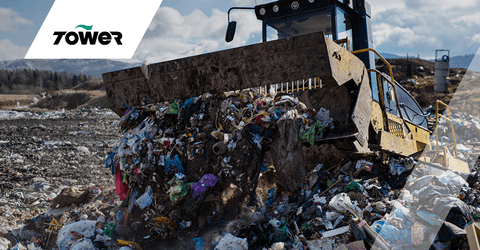
Branded workwear, company uniforms, and essential PPE is issued to employees every single day.
The correct PPE keeps workers safe with head, hand, and eye protection, safety footwear, and respiratory masks, etc. Whilst branded workwear and uniforms will proudly display a company’s logo, colours, or even a strapline and website address.
But how many UK companies are addressing or actively taking accountability and responsibility to what happens to these items of clothing and PPE whenever any of the following occurrences happen…?
The question I am asking is: Does your business abdicate the responsibility of what happens to old, outdated, or redundant items of employee workwear and PPE?
"90% of UK professional clothing goes into landfill. Less than 1% of this is reused to make new textiles."
This staggering statistic from research conducted by WRAP (Waste & Resources Action Programme), a British registered charity who promote and encourage sustainable resource use worldwide. Which was also published by the PCIAW (Professional Clothing Industry Association Worldwide) within their “Circular Textiles for a Sustainable Future” report in 2021.
Let’s just think about these numbers a little more.
90% of workwear, uniform, corporate wear, and PPE issued in the UK ends up in landfill.
The size of this issue cannot be understated in today’s climate. It’s critical we all quickly understand how the disposal of these items is directly impacting our sustainable goals, targets, and requirements. We need to immediately put focus on impacting this number and reducing what goes to landfill.
Let’s assume that the following scenario is commonplace:
An employee is issued with a nice new array of branded uniform, workwear, and PPE items, which they happily wear each day for work. These items will ensure they stay safe whilst also complying with the company’s brand values and identity.
Then one day, the employee is issued with newer or different items of workwear or PPE. What happens to the items that are now no longer required or fit for purpose? Does the employer ask for them to be returned? Are they collected for recycling or secure disposal?
More importantly: does your employer, or you as the employer, then pass this responsibility of disposal on to the individual employee?
Unfortunately, the most common occurrence is that the employee is given the task of what to do next with these items. And for some employees, this could be a combination of branded workwear clothing, uniform, or PPE items such as hi-vis vests, polo shirts, hard hats, and gloves.
At this point, the employee will be asking themselves: what can I do next? What are my options? For most other types of non-workwear clothing and equipment they would be choosing one of these:
But here’s the catch: ALL the above options are either unsuitable or irresponsible for PPE, uniform and branded workwear. Here’s why:
If the employee’s options are limited when it comes to the sustainable and responsible disposal of branded clothing and PPE, it falls onto the employer to take responsibility.
This might seem like a simple move, but first employers need to understand why taking this responsibility is not just the right thing to do ethically. It’s a smart solution with long-term benefits.
No matter the size of your company; the identity, values, and integrity of your business is your brand. It’s why marketeers and business owners are passionate and protective of the brand and what it represents. Marketing departments and owners can spend months working on branded workwear and uniform styles. A lot of thought goes into both design and manufacture. Not to mention the costs involved.
But it’s so important if you want the correct balance of protection, comfort, and branding. This ensures that employees are not just safe and comfortable, but also represent your brand/company in the best way.
With all this time, effort, and money put into making sure your workwear and uniforms represent your brand perfectly, it seems unwise to not consider the brand reputation beyond its ‘wearable’ life.
After all, employees must follow a code of conduct on how to act and be responsible whilst at work, especially when wearing branded clothing or within liveried vehicles, to ensure the brand/company is always represented in the best way.
So, what can happen to your brand and identity if garments are not disposed of responsibly or securely?
One potential threat to a company’s reputation, credibility or brand would be identity fraud or misrepresentation of the company by a person not employed by the company. They might have obtained the uniform or workwear online or via a donation bin or charity shop, then falsely impersonated, or misled people for illicit gain.
Someone could dress as a utilities provider to gain entry to homes under false pretences. Another example is impersonating a courier company and pretending to have a package to deliver. In most cases these are criminal acts, not to mention fraudulently associating to a company or brand.
And this will nearly always be down to just a simple lack of secure, responsible disposal and destruction of branded workwear.
An employer who truly values their brand reputation, will implement a secure garment recycling and destruction scheme to solve this threat and reclaim the ownership of workwear and uniform.
Professional clothing can be recyclable, sustainable, and eco-friendly. Whether that be garments that are manufactured using recycled materials, items that are fully recyclable at end of life, or sourced garments that are deemed more sustainable through an extended lifetime usage.
All these garment and PPE options are not a direct correlation to cost and are available right now. This refutes the assumption that disposable textiles are a sustainable or responsible approach to clothing. Buying cheap low-quality items is a false economy that has ramifications and impacts on sustainability.
The awareness and public social responsibility of a sustainable future was brought into focus by the COP26 UN Climate Change Conference in Glasgow in October 2021. Sustainability goals, targets and values are now the challenge of today for companies, whether global, European, or local.
Making sustainability a top consideration when managing your workwear is a change that every company can make. And it will have an immediate effect. This could include issuing sustainable workwear, biodegradable PPE items, uniforms made from recycled textiles, or taking responsibility for ensuring all items are collected and recycled at the end of their lifecycle.
It’s a simple change that has a big impact.
I am a marketeer. And have been for over 25 years. So, I can speak with a level of authority and guilty association on this matter. The truth is that marketing teams can at times lose insight and visibility when it comes to the practicality and impact of designing and branding workwear.
Marketing teams focus on how it all looks, the logo, and the brand colours. They worry about representation and perceptions to their audience, and whether the workwear and uniforms are ‘on-brand’. But these oversights can impact sustainability goals and add to the overall costs of the workwear, uniform, and PPE. Let me give you a hypothetical scenario…
A marketing brand team design a visually stunning workwear item for a company’s fleet of delivery drivers. The polo shirt is resplendent with logos, slogans, and the all-important website address. Adorning the front, back and sleeves of the garment, is a gorgeous bespoke colourway with design accents on the collars and cuffs. Everyone loves the design. And the sample clothing looks great.
But what if the company’s health and safety policy and risk assessment states that whenever the delivery driver for this company leaves their vehicle, they must be always wearing a long-sleeved hi-vis vest? The oversight is obvious. It’s likely nobody will get to see all the branding on the clothing.
Setting aside the design costs and the increased manufacturing costs to personalise and add all the elements of personalisation to this garment, where are the sustainable considerations? What were the wearer’s needs and requirements in the garment to allow them to do their job to the best of their abilities? What was the end of lifecycle plan for the garments?
The marketing team’s obsession with design and brand didn’t consider the wearer or any sustainable considerations or what happens at the end of a garment’s life.
As a marketeer, I of course recognise the importance of branding when designing a uniform. But this aspect must be considered in conjunction with the circular economy and sustainability goals of the company.
Now when I approach workwear and uniform design I always ask: “How do I brand workwear that meets the business needs in a sustainable and recyclable manner for the entire lifecycle of an item?”
So, what’s the answer to this problem? What can an employer that wants to be conscientious and responsible for workwear and PPE do? How can they make sure that they design and use workwear that supports the sustainable circular economy and addresses recyclable needs? How can they stop abdicating responsibility to their employees for workwear and PPE disposal?
The great news is that there are many options available to employers for workwear, uniform, and PPE today; right now!
This includes sourcing sustainable items at the design and procurement stage, using a ‘cost in use’ model to extend a product’s lifetime value in use, and adopting an end-of-product lifecycle process that includes recycling and secure disposal and destruction of branded workwear, uniform, and PPE.
Here at Tower Supplies we’re proudly leading the conversation and developing solutions for sustainable workwear, uniform, and PPE.
We believe we have the answers so please ask the questions.
To join the conversation, please challenge us. Ask Tower to advise, guide and make your workwear, uniforms, and PPE more sustainable, branded and meeting your business needs and goals.

Gary drives the marketing strategies and campaigns across our sales divisions, building on Tower’s brand strength whilst aligning the category and propositions for Ctrl Cloud, WorkBear and Helm.